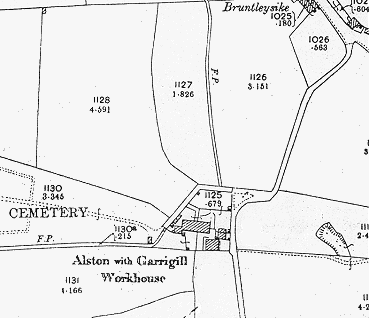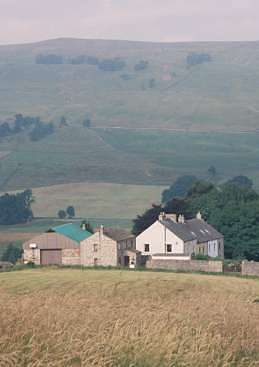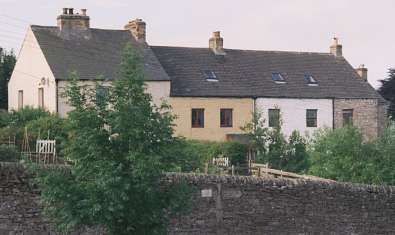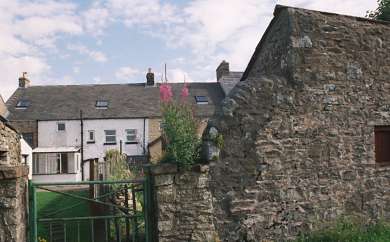Alston with Garrigill, Cumberland
Up to 1834
Alston parish workhouse is believed to date from the mid-18th century. A parliamentary report of 1777 records a workhouse in operation in Aldston (an old spelling of Alston) able to accommodate up to 40 inmates.
In 1832, the governor of the workhouse, Mr Richard Sanding, died suddenly at the age of 68.
After 1834
The Alston with Garrigill Poor Law Union formally came into being on 4th March 1837. Its operation was overseen by an elected Board of thirteen Guardians. The Union's population in 1831 had been 6,858 and the average annual poor-rate expenditure for the period 1834-36 had been £1,912 or 4s.2d. per head of the population.
The new union took over the existing parish workhouse at Alston and enlarged it. The building comprised a block of four houses in a sloping terrace and, according to Kelly's Directory, could have accommodated up to 80 inmates. The workhouse location and layout are shown on the 1899 map below.

Alston-with-Garrigill workhouse site, 1899

Former Alston workhouse from the east, 2001.
© Peter Higginbotham.

Former Alston workhouse from the north, 2001.
© Peter Higginbotham.

Former Alston workhouse from the south, 2001.
© Peter Higginbotham.
On Christmas Day, 1851, the inmates of the workhouse were supplied with a dinner of roast beef and plum pudding, with ale, and after dinner tobacco to the aged. On New Year's Day, the Rev. Hugh Salvin, Vicar of Alston, gave them a dinner of roast beef with buns, and in the evening tea, coffee, and spice cake. Tobacco was also given to those who made use of it, and oranges to rest.
Following a visit to the workhouse in 1862, Joseph Rowntree of Leeds submitted a report to the Carlisle Journal, part of which is reproduced below:
I found the house thoroughly clean. The food I saw supplied for dinner was excellent, whilst some additional improvement to the aged and sick is desirable. I must only make few passing remarks. I consider the surgeon has the power to recommend many needful changes. I regret to state that the straw beds were not generally supplied with blankets. The old women were the exception; they were only allowed one old thin one. The cotton coverlets and sheets are quite inadequate for the requirements of the inmates, especially daring the winter. They have no paid chaplain, hence the Dissenting Ministers should be allowed and invited to visit the workhouse regularly, and lady visitors also. They should not be objected to by the Guardians or those in charge of the place, whose unwillingness to have the aid Dissenters was apparent.
The education of the boys and girls at Alston provided for the guardians sending them to the Free School the town. I asked them a few exceedingly easy questions, which they could not answer. There was only one exception.
A government inspector in 1866 recorded that:
This is an old parochial establishment, standing on the summit of a hill a short distance from the town of Alston. The number of inmates rarely exceed 40, and there is provision for 80. Its chief defect has been want of classification, which is now, fairly provided for men, women, boys, and girls. The provision for sick and infectious cases is in the main building, and appears to be suitable, but the separation of the latter from the other sick inmates is probably not so complete as it should be, and there are no sick wards exclusively for children. In a separate building of two stories, distinct from the workhouse, and in the Workhouse garden, there are four rooms used as receiving and vagrant wards for each sex. The ventilation, light, water supply, and drainage of the premises are satisfactory.
The beds are clean and comfortable, and the furniture, utensils, and conveniences for washing sufficient, and in good condition.
The classification of the inmates is fairly carried out; their diet and clothing are good, and medical attendance sufficient.
The nursing is performed by the inmates.
A weekly service is held on Wednesdays by the vicar of Alston, who performs the duties of chaplain gratuitously, and on Fridays by a Dissenting minister, at which the inmates who think proper are present, children excepted, and those who request it are visited by any minister they may desire.
The children are sent to two different schools in Alston, and receive a fair education.
Bulmer's Directory of 1901 recorded:
Possibly because of the limited space at the workhouse, the Board of Guardians had their regular meeting at Alston Town Hall.
The workhouse was closed in 1917 and the remaining inmates were boarded out at the Brampton workhouse. The building was put up for sale in 1920. The premises are now used as private housing.
Staff
Inmates
Records
Note: many repositories impose a closure period of up to 100 years for records identifying individuals. Before travelling a long distance, always check that the records you want to consult will be available.
- Carlisle Archive Centre, Lady Gillford's House, Petteril Bank Road, Carlisle CA1 3AJ. Holdings include: Guardians' minutes (1837-1930); Ledgers and accounts (1835-1930); Tobacco and snuff register (1913-16); etc
Bibliography
- RN Thompson (1978) The Working of the Poor Law Amendment Act in Cumbria, 1836-1871 in Northern History, Vol XIV.
Links
Unless otherwise indicated, this page () is copyright Peter Higginbotham. Contents may not be reproduced without permission.


